I made a hooded cloak for Rowany Festival this year. I think I need to share the documentation I managed for this around a bit, because most people (including me a year ago) think hoods and hooded cloaks didn't exist in the 12th Century, and this will prove to you, dear reader, that that is just not true.
This is going to take a few entries, so please be patient. (or nag me, sometimes it works)
Let's start with pictures of shepherds wearing hoods and hooded cloaks. One of the main reasons we see a lot of unhooded cloaks is because of the mantle. The mantle was the cloak of the nobility, a ceremonial garment (frequently heavily decorated) and a marker of rank. Thus when nobles are depicted in art, it is generally wearing that marker of their rank. I mean would you depict a policeman as a plainclothes detective or a bobby in uniform if you wanted an audience to know what was happening? Precisely. Literary references tell us that the french and Anglo-Norman nobility wore hooded cloaks while travelling and for lower classes this was the only type of cloak available - called the chape. I'll get to those references later, but for now, I'm telling you this, in relation to shepherds - shepherds are depicted often as part of the nativity story and are stereotypically low ranked people who work outdoors. Thus they are a great place to look for what peasants wore outdoors.
 The Hague, KB, 76 F5 (Picture bible )
The Hague, KB, 76 F5 (Picture bible )
North-western France (Monastery St. Bertin?) c. 1200
Fol. 10v Annunciation of Christ's birth to the shepherds
- A hooded cloak, may or may not open at the neck. Hood tapers to a rounded end.
- cloak has a bit of a corner at the hem, or is it just the way it folds?
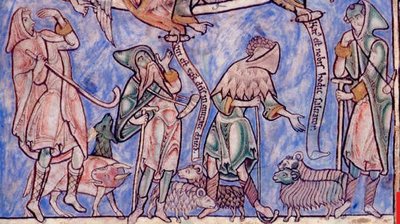 British Library MS Cotton Nero C. IV (Winchester Psalter) Winchester [Priory of St Swithun or Hyde Abbey], England; between 1121 and 1161
British Library MS Cotton Nero C. IV (Winchester Psalter) Winchester [Priory of St Swithun or Hyde Abbey], England; between 1121 and 1161Folio11 Annunciation to the shepherds
- Plenty of Variety means there were probably plenty of options available.
- Some hooded cloaks that either fasten at the neck or are sewn together there (seems less likely). Note how these are much longer at back than front.
- Also notice the corner on the cloak hem of the man on the left - I have a theory about this, that I'll write about eventually.
- The Hood appears to have been made from fur or sheepskin, by the texture depicted.
- The remaining cloak is difficult to tell details on, other than being hooded, and longer than a normal hood.
 St Albans Psalter
St Albans PsalterEngland c1120-1140
page22: the annunciation to the Shepherds
- An orange hood and a red cloak that doesn't open at front.
- Both have yellow lines at edges - probably indicate a lining or binding
- both have a seam down the top of the head.
- lines also indicate stitching along edges with yellow borders, and i think there might be a seam down the arm of the orange hood. This implies that there aren't any other seams present.
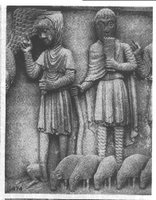 Chartres Cathedral carving, 12th-13th C France
Chartres Cathedral carving, 12th-13th C FranceShepherds in Summer
- Man on left wearing A short hood with fairly pointed back of head
- Man on right's cloak stands up a little on the left of his head, this may be a hood that is not pulled up?
 Thott 143 2º: The Copenhagen Psalter
Thott 143 2º: The Copenhagen PsalterEngland, 1175-1200Figure 13. Thott 143 2º: The Copenhagen Psalter
England, 1175-1200.
Fol9r. The Annunciation to the Shepherds.
- Hood has a bit of a slit at the front neck. This probably makes it easier to pull on. And could mean a seam is located here.
- The back of the hood is much longer and less pointy

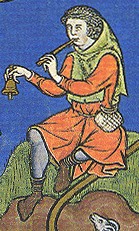
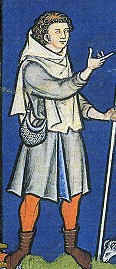 Morgan Library ms m.638 (Maciejowski Bible)
Morgan Library ms m.638 (Maciejowski Bible)Paris 1244-1254AD
Fol 32r. David obtains Goliath's sword, bystander holding shepherds crook Fol 27r. The shepherd, David
Fol. 25r. The shepherd, David
- Note - 13th C example
- The left two seem to have left out a gore on the hood to make it easier to move the arms.
- There is a strange notch at bottom front that may mean a seam is located here?
- The one on the right is more conventional, a bit longer at the back than front.
- It appears to be lined
- At the front of the neck there is a small line which may mean a seam here.
 Frescoes from the vault of the Pantheon of Kings
Frescoes from the vault of the Pantheon of KingsLeon, San Isidro 12th Century
Annunciation to the Shepherds
- Cloak with hood, front opening
- Notice how the cloak has a corner at the hem.
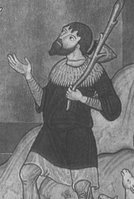 Bibliothéque Nationale, Paris, Ms17325 Periscope book
Bibliothéque Nationale, Paris, Ms17325 Periscope bookRhine-Weser region c1140
Fol 8vAnnunciation to the shepherds
- Might just be a hat thats been knocked off, but objects are rarely shown in motion
- the collar section around his neck is fur. That could mean a fur hood or just a hooded tunic with fur collar, or something else entirely.
Peasants working in the fields is also a subject that gets illustrated to represent the seasons in calendars.

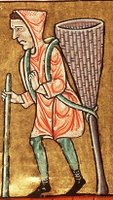 The Hague, KB, 76 F 13 (Fecamp Psalter )Normandy (Fécamp?); c. 1180
The Hague, KB, 76 F 13 (Fecamp Psalter )Normandy (Fécamp?); c. 1180Fol. 3v March: men pruning
Fol. 3v March: men tying up and planting vines
Fol. 10v October: men sowing and ploughing;
- Hooded tunics - practical for working. Not just for monks.
- Notice the seam down the top of the hood on the left.
- very pointy hoods. Notice how the one on the left remains pointy even when off the head.
 Figure 17. Morgan Library ms m.638 (Maciejowski Bible,)Paris 1244-1254AD
Figure 17. Morgan Library ms m.638 (Maciejowski Bible,)Paris 1244-1254ADFol 17v. Ruth dines with boaz (peasant meal just after harvest)
- Another 13th C example
- Lots of hoods, with notches at centre front - a seam here?

 Figure 18-19. Florence, Laurentiana MS Plut. XII 17
Figure 18-19. Florence, Laurentiana MS Plut. XII 17Canterbury early 12th Century
Fol 1v The bad and the good and regiment
- on the left a hooded cloak, no front opening, longer at back
- a seam along the top of the head
- On the right, a hooded tunic
Conclusions
- There were a variety of hoods and hooded garments worn by peasant folk. It is definitely from this pictorial evidence that hoods and hooded cloaks are being worn in the 12th Century
- The variety of shapes probably indicates a variety of ways of cutting such garments
- Quite a few examples have a seam down the top of the head. Most of these are pointier than the rest.
Next Installment: The common man and travellers.

4 comments:
I wonder if the apparently sleeveless chapes are simply tucked up. You might do this if you need to wave your arms around, as the examples shown are doing. Compare with T-tunics with a slit in the front, which are often shown tucked up when people do manual labour in the Maciejowski bible.
Just tried this with my hood. Seems to work.
Sounds plausible, but notice the sharp edge of fabric visible, with a corner, on either side of the arm. I'll need to see that corner reproduced to know that this is what's happening in this illustration. I look forward to seeing you demonstrate folding your hood up.
the other thing I've noticed since then was someone with a hood that had fairly small gores and managed to situate them so thye had a bit of this effect happening. I think what they did was used lightly too small gores for the size of the garment, so it naturally hung a bit like this. It was a shorter version though. I think the person's version I saw was pure fluke, but I think it does go towards the omitted gore version too. The value of omitting a gore for poor people is fabric efficiency too. More experimentation on this needed too.
Again, no one way to do things, as these pictures clearly show.
Yes, ok. To my eye the images are a bit contradictory... the shoulder looks tucked up, there's no distinct color for the lining, but there is also that sharp edge at the bottom.
Shoulders often look a bit tucked up, but the guy in the next picture with a more normal chape/chaperon doesn't have tcked up shoulders.
Perhaps the answer lies between out two solutions - if the design has less fabric on the sides, and then is tucked up on the shoulders, perhaps we can end up with this effect?
I think we also need more pictures. I'm pretty sure there are more in the mac bible, and I think I saw one rare one like thiselsewhere, but I can'tthink where. Hopefully it's in my file at home.
Post a Comment